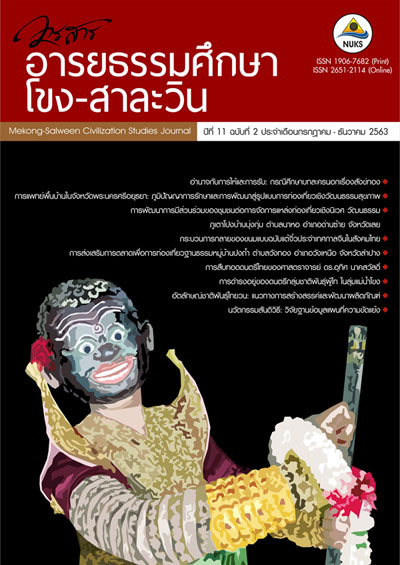Tai-Yuan Ethnic Group: Conceptual Framework for Creation and Product Development
Main Article Content
Abstract
This article presents the results of the research, performed on cultural capital and local wisdoms which were reflected from cultural identities regarding life style of Tai-Yuan, an ethnic group in Tontan Sub-district, Sao Hai District, Saraburi, Thailand, in the context of cultural assimilation due to social changes nowadays. The main purposes of this study were 1) to study contexts and problematic issues in Tai-Yuan community, 2) to study Thai-Yuan identities, and 3) to design products reflecting their life-style identities. Qualitative and quantitative research methods were conducted in this study. There were three main findings as follows: 1) people in Tontan Sub-district were Yuan origin which affected their sense of belonging in cultural heritage, especially the senior members who were more customary and pursuing inheritance passed on from their predecessor. Unfortunately, rapid social change became a deculturated issue of the community since some of the young generations decided to move out from their motherland to find jobs elsewhere. Consequently, those wisdoms had been left behind. This wisdom was only considered to be important among the seniors. Therefore, a development of locally unique identity would sustainably bring back a sense of awareness and appreciation in the local wisdoms, 2) textiles and outfits were demonstrations of the local identity as they reflected sentimental and cultural values as well as history, and 3) Tai-Yuan identity was represented as a creation of new products. The finding showed that workshops would increase the cooperation between researchers and local people. Young generation could generate the newer contemporary patterns, adding value to the existing product.Young generation will become more aware of sustainable preservation of their cultural inheritance.
Downloads
Article Details
References
Deewong, P. (2013). The International Cultural Hybridization on Television. EXECUTIVE Journal, 33(1), 87-94.
Goulding, C. (2001). Romancing the past heritage visiting and the nostalgic consumer. Psychology and
Marketing, 18(6), 565-592.
Mckercher, B., & Du Cros, H. (2002). Cultural tourism: The partnership between tourism and cultural heritage
management. New York: The Haworth Hospitality Press.
Patmasiriwat, D. (2004). The Social and cultural capital in economic system and modern management.
Proceeding of Naresuan University 2004. Bangkok: P.A. living Co., LTD.
Rugmai, T. (2013). The process of making an art activity based on relational art for social inclusion of children
with special needs. (Doctor dissertation). Chulalongkorn University, Bangkok.
Santasombat, Y. (1999). Khwamlaklai thang Chiwaphap lae Phumpanya Tongthin phua Kanphatthana Yang
Yangyun (biodiversity and indigenous knowledge for sustainable development). Center of Biodiversity and
indigenous knowledge for substainable development, Faculty of Social Sciences, Chiang Mai University.
Triamanurak, J. (2012). The Art of Intervention. Retrieved from http://www. matichon.co.th/news_detail.php?
newsid=1340194299.
Wetchawong, D. (2010). The presentation of the Yuan ethnic identity in the context of tourism via local museum
and riverside market: A case study of Yuan community, Tombon Tontan, Sao Hai district, Saraburi province.
(Master’s thesis). Chulalongkorn University, Bangkok.
Yakul, S. (2015, September 12). Interview. Local wisdom elite, Tontan sub-district, Sao Hai, Saraburi, Thailand.
Yakul, S. (2015, October 25). Interview. Local wisdom elite, Tontan sub-district, Sao Hai, Saraburi, Thailand.
Yakul, S. (2015, November 15). Interview. Local wisdom elite, Tontan sub-district, Sao Hai, Saraburi, Thailand.


